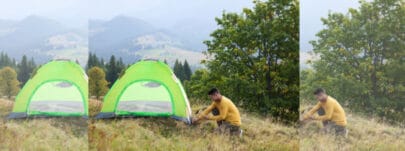
Tips for First-Timers Camping with CPAP Devices
All of us enjoy the allure of the great outdoors on occasion. Camping is also one of the best ways to immerse ourselves in nature and take a hiatus from everyday life.
However, those who have been diagnosed with obstructive sleep apnea might falsely believe that such excursions are impossible due to the supposed limitations of CPAP (continuous positive airway pressure) devices.
This is hardly the case. There are several ways you can enjoy all that Mother Nature has to offer and still get a good night’s sleep. Let’s review a handful of practical tips and tips so that you can plan your next outing well in advance.
Access to Electricity
One of the first questions to ask is whether or not you will have access to electricity. This partially depends on where you are staying and the amenities that you plan to bring along. For instance, the majority of nature preserves offer camping sites with electrical connections.
Many sleep apnea devices can likewise be adjusted in order to accept various foreign power supplies. While this might not always be relevant, it is important for those who might be taking a vacation.
On-the-Go Comfort
Let’s now assume for a moment that you are a camping traditionalist or the location you plan to backpack to a remote location. In this case, you will be presented with two general options:
- Using a PAP adaptor that can be fitted to the battery of a vehicle.
- Bringing along a portable power supply.
The good news is that well-known units can accommodate both scenarios. For instance, the ResMed S8,S9, AS10 and AS11 may be used in conjunction with inverters that can adapt to power supplies of both 12 and 24 volts. Note that the converters might need to be purchased separately.
The other possibility (and the most popular choice) involves the use of a standalone power supply. The ResMed Power Station II is a perfect example of just how far this technology has come. These units are lightweight, portable, easy to manipulate, and capable of providing a steady source of electricity for hours at a time before they need to be recharged.
What About the Device Itself?
Now that we have covered the basics in terms of powering your device, we should examine a few practical concerns. One of these involves the size of the CPAP itself. After all, you might be dealing with a limited amount of space when camping. Ergonomics therefore play another role.
If your standard home-based unit is too large or bulky, consider purchasing another that has been designed with a more portable nature in mind. The ResMed AirMini AutoSet is a prime example of how great things sometimes come in small packages.
Additional Tips and Tricks
So, what other factors should you choose to address in advance? We need to remember that camping can sometimes be associated with unpredictable situations (such as a sudden change in weather conditions). This is why it once again pays to plan ahead. We will now examine some other relevant factors.
Features and Accessories
Modern PAP devices offer a host of customized features that can be adjusted to your personal requirements. This is why you should ensure that the device is able to be configured to the settings that you have become accustomed to at home. Examples include pressure, possible ramp options and the ability to track sleep data.
This is also when we should mention the importance of a humidifier. If you are dealing with extremely dry conditions, the device should contain a built-in humidifier. Your sleep apnea symptoms might otherwise become worse in a relatively short period of time.
Finally, try to choose a PAP device that runs relatively quiet during the overnight hours. Silence is indeed golden when enjoying the great outdoors to the fullest!
Durability
From a purely pragmatic perspective, some units are more robust than others. It makes little sense to spend your first camping night fiddling around with fragile accessories such as hose connections and power cords. Take some time to examine the characteristics of various units in order to understand which one offers a robust edge.
Face Masks
If you have recently purchased a positive airway pressure device solely intended to be used while camping, always determine whether your existing hose and face mask are compatible. There can be times when swapping these accessories between different brands will result in an incorrect fit, dramatically impacting your sleep apnea symptoms while away from home.
Warranties and Insurance
While the majority of PAPs are covered by insurance, this is not always the case for portable units. From a financial perspective, determine whether your provider will cover the device. Furthermore, check the warranty to understand if the portable CPAP is indeed suitable for outdoor conditions (if accidentally exposed to rain, for example).
The Best PAPs for the Great Outdoors
Here’s a list of the top PAPs that are popular with campers. Here are three sure-fire suggestions:
- The ResMed AirMini Travel
- The Somnetics Transcend Micro Auto Travel (currently the smallest device)
- The HDM Z2 Auto Travel (the lowest decibel levels)
There is no reason why obstructive sleep apnea should prevent you from enjoying all that nature has to offer. With a bit of foresight and planning, your next excursion will provide memories to last a lifetime!
Sources:
1.https://www.sleepquest.com/best-portable-cpap-machines-for-camping/
2. https://www.sleepquest.com/what-is-a-travel-cpap-machine/



